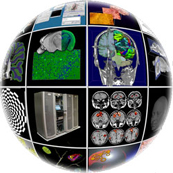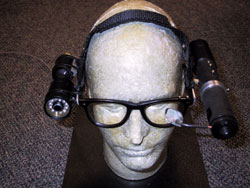 |

|
 |
The United States flag flies at half-staff over the National Science Foundation's Amundsen-Scott South Pole Station
The United States flag flies at half-staff over the National Science Foundation's Amundsen-Scott South Pole Station to commemorate the passing of former President Ronald Reagan. The Aurora Australis, or Southern Lights, highlight the night sky.
(posted June 10, 2004)
|
 |
|
 |
The Biomedical Informatics Research Network (BIRN) promotes advances in biomedical and health care research through the development and support of a cyberinfrastructure that facilitates data sharing and multi-institutional collaboration. The GRIDS Center Software Suite from the NSF Middleware Initiative (NMI) is essential to providing many of the underlying mechanisms critical to achieving this infrastructure. Sponsored by the National Institutes of Health's (NIH) National Center for Research Resources (NCRR), the BIRN's charter is to create an environment encouraging biomedical scientists and clinical researchers to make new discoveries by facilitating sharing, analysis, visualization, and data comparisons across laboratories.
Credit: Biomedical Informatics Research Network
|
Brain Disease Research, Particle Physics Meet in the Middle(Ware)—NSF Middleware Initiative Proves Key for Grid-Based Collaborations in Diverse Disciplines
The study of Alzheimer's disease and the analysis
of particle collisions may not appear to have much in common, but
behind the scenes, middleware being developed with support from
the National Science Foundation (NSF) is helping groups of researchers
in neuroscience, physics, and other fields to apply the power of
grid-based computational resources. Spanning 14 universities and
22 research groups, the growing Biomedical Informatics Research
Network (BIRN) is establishing the cyberinfrastructure, or integrated
information technology configuration, needed to facilitate health
care research for large-scale data sharing and analysis.
More...
(posted June 4, 2004)

|
 |
|
 |
The head-mounted components of the Wearable Low Vision Aid. Shown are the camera with a ring of IR LEDs (left) and the head mounted display (right).
Credit: Human Interface Technology Laboratory at the University of Washington.
|
"Heads-Up" Display Lives Up to Its Name—
Student-Designed Device Helps the Visually Impaired Avoid Hazards, Day and Night
Using a common laptop computer and a sophisticated
head-mounted projection device, students at the University of Washington
(UW) have created a system to help people with poor vision navigate
around stationary objects. The Wearable Low Vision Aid (WLVA) is
the first portable device to draw attention to obstacles using an
illuminated, vibrating crystal that projects a warning icon-a raster
image much like a television's-onto the user's retina. The system
was built entirely by graduate and undergraduate students over the
past four years under the direction of Eric Seibel, research assistant
professor for mechanical engineering at the Human Interface Technology
Laboratory at UW.
More...
(posted June 4, 2004)

|
 |
|
 |
Clusters of two, three and four permeable ellipsoids, generated from the percolation simulations of Yun-Bo Yi and Ann Marie Sastry.
Credit: Yun-Bo Yi and Ann Marie Sastry, University of Michigan
|
Staying on the Path, One Atom at a Time—New Percolation Model May Allow Researchers to Study Biochemistry at the Atomic Level
A new report in the May 24, 2004 Proceedings of the Royal Society of London. Series A: Mathematical and Physical Sciences announced a mathematical model that will help researchers understand "cell signaling" and learn how single atoms travel along the circuitous pathways in a cell. The model is a new approach to look at percolation-the flow of a liquid or small particle through a porous material. In the simulation, materials pass through fields of complex, three-dimensional shapes, a scenario that is closer to real-world environments than existing two-dimensional models and models incorporating simpler shapes.
More... (posted
June 4, 2004)

|
 |
|
 |
These images show the brightness, magnetic field strength, and Doppler velocity of an erupting solar prominence taken with the Coronal Multi-Channel Polarimeter on March 9, 2004. The images were taken in a wavelength region in the near-Infrared spectrum corresponding to emission from Helium atoms. Positive and negative polarities of magnetic fields are indicated by the yellow and white colors of the middle image, while velocities directed towards and away from the observer are indicated by the blue and red colors of the rightmost figure.
Credit: National Center for Atmospheric Research
|
Instrument Gets Breakthrough Image of Sun's Magnetic Halo
A new instrument developed at the National Center for Atmospheric Research (NCAR) in Boulder, Colo., has captured landmark imagery of fast-evolving magnetic structures in the solar atmosphere. Steven Tomczyk of NCAR's High Altitude Observatory presented the images at the annual meeting of the American Astronomical Society (AAS) which took place in Denver, Colorado on May 31, 2004. Animations from the coronal multichannel polarimeter, or COMP, reveal turbulent, high-velocity magnetic features spewing outward from the Sun's surface. The National Science Foundation-NCAR's primary sponsor-funded the instrument.
More...
(posted June 4, 2004)

|
 |
| |

|

